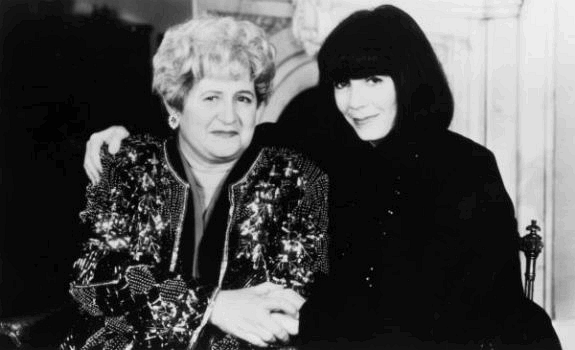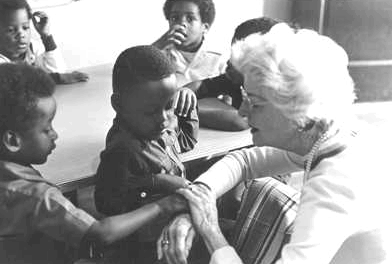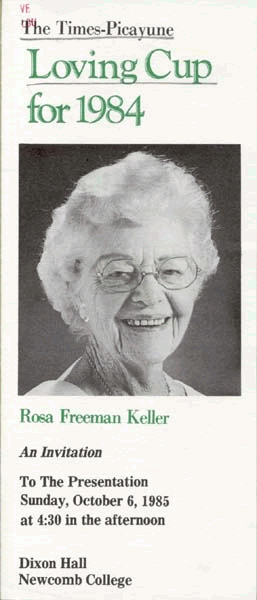|
Today in New Orleans History |
|
|
October 6

 To receive an update for each day in New Orleans history,
join our facebook page - Today in New
Orleans History.
Alice O'Brien Borchardt is Born Alice Borchardt, left, and her sister, Anne Rice in Houston. Photo from the Houston Chronicle
"Storytelling came easy for Houston novelist Alice Borchardt, even as a young child growing
up in New Orleans when she would share her fancy tales with her younger sisters at their urging", wrote Renee C. Lee
in the Houston Chronicle about Alice O'Brien Borchardt. One of those four sisters was novelist Anne Rice. "Alice
loved to write," Anne Rice said in a statement to The Las Angeles Times. "She had a natural ear for beautiful language
and was a natural storyteller." "We want to be the Bronte sisters," Rice said in a 1995 interview with
the Houston Chronicle, referring to the sisters who wrote the gothic novels "Jane Eyre" and "Wuthering Heights."
"We want to go down in history." Alice O'Brien Borchardt was born in New Orleans
on October 6, 1939. She moved with her family, as a teenager, to Richardson, Texas. After a career in
nursing, she began to write historical fiction, fantasy, and horror. Her sister Anne encouraged her, helped her find
an agent, and wrote introductions to several of her books. The first of her seven novels, Devoted, was published in 1995.
She is best known for a trilogy about werewolves in medieval Rome. In her Legends of the Wolves trilogy, (The Silver Wolf,
Night of the Wolf and The Wolf King,) the orphaned Regeane and the nobleman Maeniel, both are part wolf and part human,
contend with bullying chieftains, embattled emperors and supernatural interventions. The last book in the series was published
in 2001. Alice died on July 24, 2007 at the age of 67 after a long battle with cancer.  To receive an update for each day in New Orleans
history, join our facebook page
- Today in New Orleans History
Already a member of the New Orleans
chapter of the League of Women Voters, Keller began her foray into the world of politics working on voter registration. When
her mother died in 1945, Keller was asked to serve on the local YWCA board, an integrated organization that deeply impacted
her views on race relations. In 1947, seeking to alleviate the housing shortage for New Orleans’s black families, Rosa
and Charles Keller, along with friends and philanthropists Edith and Edgar Stern, financed the construction of Pontchartrain
Park, one of the first middle-class black communities in the country.
Keller expanded her political involvement in the early 1950s when she helped organize the Independent Women’s
Organization, created to support the election of moderate mayoral candidate deLesseps Morrison. When Morrison asked Keller
to serve on the board of the public library system, she readily accepted, becoming the first woman to serve on a citywide
board. Almost immediately Keller brought controversy to her position when she set out to integrate the New Orleans public
library system—a goal she eventually achieved. Keller continued to serve the New Orleans black community in a
variety of ways. She chaired the board of Flint-Goodridge Hospital, a facility that catered to the black community. In this
capacity, she fought for and won access to Blue Cross coverage for the New Orleans black community, and insisted that African
American medical students have access to New Orleans’s medical libraries. Keller also served as president of the New
Orleans Urban League, and on the boards of numerous citywide interracial organizations. In 1953, Keller decided that
it was time the League of Women Voters, an organization she loved, begin the process of admitting black members. With the
help of her progressive peers, she succeeded in integrating the organization in 1955. State laws passed in the wake of the
U.S. Supreme Court’s decision in Brown v. Board of Education, however, forced to the league to resegregate a year later.
Through Keller’s persistence, the league permanently achieved integrated status in 1963. In 1958 Keller led
the fight to desegregate the New Orleans public transportation system, but she considered her efforts to integrate the city’s
public schools as “her war.” Toward this end, Keller helped create Save Our Schools (SOS), an organization dominated
by elite white women in the New Orleans community. During the 1960 New Orleans School Crisis, when the first
black children attended formerly all-white schools, SOS ferried children to and from the integrated schools. They also raised
monies for the black and white families who kept their children in the schools and lobbied the state legislature on behalf
of integrated schools. Much to the chagrin of some family members, Keller also personally financed the legal fight to desegregate
Tulane University in 1963. Through the years, Rosa Keller had no qualms about holding interracial gatherings in her Uptown
home, though it was considered a serious breach of racial etiquette at the time. Keller received numerous honors for
her work on racial issues in New Orleans, including the Times-Picayune Loving Cup Award, which honors New Orleans residents
who have worked unselfishly for the community without expectation of public acclaim or material reward. She also received
an honorary alumnus degree from Newcomb College and an honorary doctorate from Dillard University.
She died in April 15, 1998, in New Orleans. The Keller Family Foundation, established in 1949, continues
to provide monies to sustain and improve the New Orleans community. The Rosa F. Keller Library
& Community Center at 4300 S. Broad was named for her on October 6, 1999 Frystak,
Shannon. "Rosa Keller." KnowLA Encyclopedia of Louisiana. Ed. David Johnson. Louisiana Endowment for the
Humanities, 31 Jan. 2011. Web. 20 Nov. 2013.
1837 1829 |
|
|

To receive an update for each day in New Orleans history,
join our facebook page - Today in New
Orleans History.
Analytics |

 Story by Shannon Frystak
Story by Shannon Frystak Rosa Freeman was born March 31, 1911, to Alfred Bird “A.B.” Freeman and Ella West. While her
mother descended from a family of southern aristocrats, Rosa’s father was a salesman—a “nobody from nowhere”—until
he made a fortune with his fledgling Coca Cola business. With his success, the family gained entrance into the world of the
New Orleans elite. After high school, Rosa Freeman attended
Rosa Freeman was born March 31, 1911, to Alfred Bird “A.B.” Freeman and Ella West. While her
mother descended from a family of southern aristocrats, Rosa’s father was a salesman—a “nobody from nowhere”—until
he made a fortune with his fledgling Coca Cola business. With his success, the family gained entrance into the world of the
New Orleans elite. After high school, Rosa Freeman attended 
